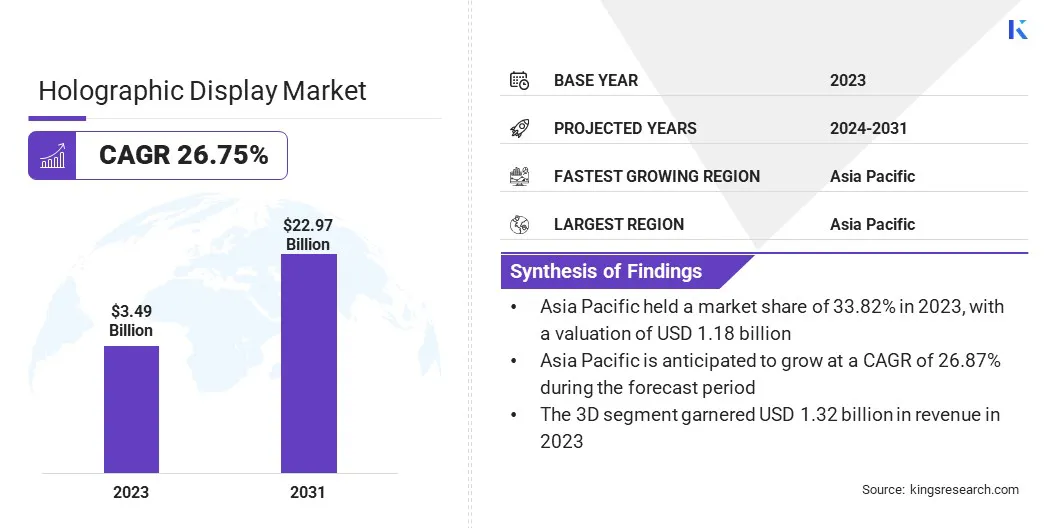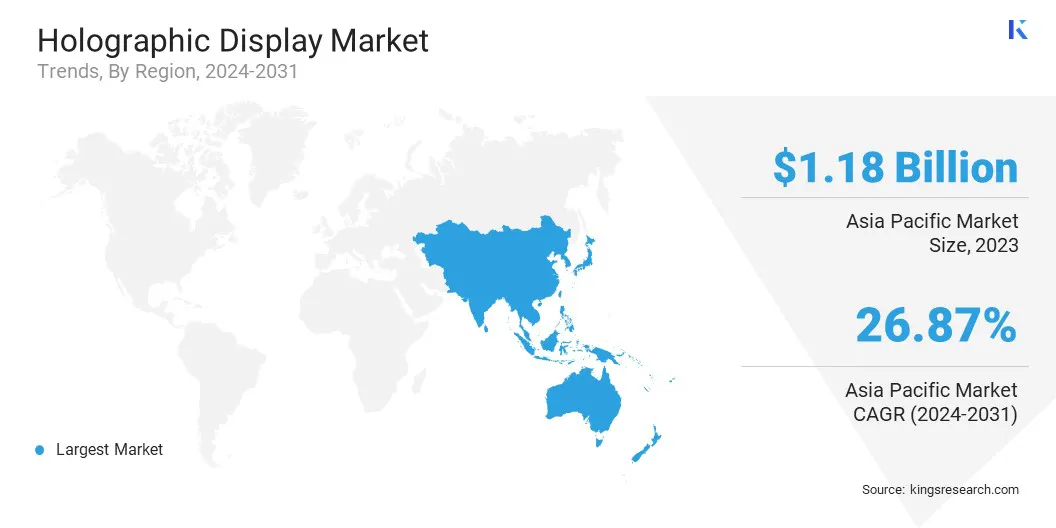Market Definition
A holographic display is a type of screen that creates 3D images that appear to float in mid-air, without needing special glasses or other equipment to see them. It uses light to project images in a way that they look three-dimensional and can be viewed from different angles. It presents a 3D version of a regular screen but with a more lifelike and immersive experience.
The report presents a comprehensive analysis of the key market drivers, emerging trends, and the competitive landscape, which are expected to determine the growth dynamics in the market throughout the forecast period.
Holographic Display Market Overview
The global holographic display market size was valued at USD 3.49 billion in 2023, which is estimated to be USD 4.37 billion in 2024 and reach USD 22.97 billion by 2031, growing at a CAGR of 26.75% from 2024 to 2031.
The integration of holographic displays into public transport systems is a significant driver of the market. These displays enhance the passenger experience by offering interactive, real-time information while being energy-efficient and space-saving, catering to modern transport needs.
Major companies operating in the holographic display industry are MDH Hologram, RealView Imaging Ltd, Axiom Holographics, HYPERVSN, Shenzhen SMX Display Technology Co.,Ltd., Looking Glass, REALFICTION, Vision 3D, Futurotec Solutions Pvt. Ltd., Proto Inc, VIRTUAL ON LTD, HOLOCO GmbH, Avalon Holographics Inc., HOLORD, and PIXELO.
The growing demand for immersive experiences across industries like automotive, gaming, entertainment, and retail is driving the market. Businesses are adopting holographic technologies to engage audiences in new and exciting ways as consumers increasingly seek interactive and lifelike visual experiences.
These displays offer dynamic 3D visuals that captivate viewers, enhancing customer interaction and satisfaction. With advancements in technology and the expansion of augmented and virtual reality applications, holographic displays are becoming a key tool for creating innovative experiences.
- In October 2024, ZEISS announced a strategic partnership with Hyundai Mobis to develop holographic windshield displays for vehicles. This collaboration aims to revolutionize automotive user experiences by integrating advanced holographic technology, enhancing safety, comfort, and information accessibility through transparent, interactive displays.

Key Highlights:
- The holographic display industry size was valued at USD 3.49 billion in 2023.
- The market is projected to grow at a CAGR of 26.75% from 2024 to 2031.
- Asia Pacific held a market share of 33.82% in 2023, with a valuation of USD 1.18 billion.
- The laser-based segment garnered USD 1.24 billion in revenue in 2023.
- The 3D segment is expected to reach USD 8.58 billion by 2031.
- The media & entertainment segment is anticipated to register the fastest CAGR of 26.87% during the forecast period.
- The market in Europe is anticipated to grow at a CAGR of 26.77% during the forecast period.
Market Driver
Integration in Public Transport
The integration of holographic displays in vehicle windows is revolutionizing the public transport sector. This innovative approach offers enhanced functionality by displaying vital information in a visually engaging, interactive way, improving the overall passenger experience.
Additionally, the technology provides several operational benefits, including space and energy efficiency, making it an attractive alternative to traditional display systems. The capability to offer real-time, customizable content without additional physical space requirements ensures its increasing adoption in the transport industry.
- In September 2024, HÜBNER Group, in collaboration with ZEISS Microoptics, introduced holographic display technology integrated into vehicle windows. This innovation, showcased at InnoTrans 2024, provides interactive, energy-efficient, and space-saving displays. The technology enhances passenger experience by delivering real-time information and increasing functionality in public transport systems.
Market Challenge
Technical Complexity
A major challenge in the holographic display market is the technical complexity of creating high-quality, realistic holograms visible from multiple angles without distortion. Achieving such realism requires advanced light manipulation and precise optical components. Manufacturers can invest in cutting-edge holographic optical elements, advanced laser technologies, and specialized materials.
Additionally, improvements in software algorithms for rendering high-quality images and enhanced 3D projection techniques help deliver clearer, more accurate holograms, making them more practical for various applications across industries.
Market Trend
Technological Innovation
The market is registering a growing trend in the development of AI-driven, pseudo-holographic display technologies that provide immersive, glasses-free 3D experiences. These innovations are transforming how consumers interact with digital content, offering enhanced visual clarity and depth without the need for special eyewear.
This technological advancement is set to redefine sectors such as entertainment, retail, and education, providing more dynamic and engaging ways to experience spatial content while making these experiences more accessible and cost-effective for a broader audience.
- In March 2025, Metavista3D Inc. will showcased its AI-driven, pseudo-holographic display technology across Germany and Switzerland. The innovative solution promises to revolutionize 3D experiences with immersive, glasses-free displays, offering a glimpse into the future of spatial content interaction.
Holographic Display Market Report Snapshot
|
Segmentation
|
Details
|
|
By Technology
|
Laser-based, Electro-holographic, Full Parallax, MEMS-based
|
|
By Dimension
|
2D, 3D, 4D
|
|
By End Use
|
Consumer Electronics, Retail, Media & Entertainment, Military & Defense, Healthcare, Others
|
|
By Region
|
North America: U.S., Canada, Mexico
|
|
Europe: France, UK, Spain, Germany, Italy, Russia, Rest of Europe
|
|
Asia-Pacific: China, Japan, India, Australia, ASEAN, South Korea, Rest of Asia-Pacific
|
|
Middle East & Africa: Turkey, U.A.E., Saudi Arabia, South Africa, Rest of Middle East & Africa
|
|
South America: Brazil, Argentina, Rest of South America
|
Market Segmentation:
- By Technology (Laser-based, Electro-holographic, Full Parallax, MEMS-based): The laser-based segment earned USD 1.24 billion in 2023, due to its precision, high image quality, and increasing demand for holographic projections in industries like entertainment and advertising.
- By Dimension (2D, 3D, 4D): The 3D segment held 37.74% share of the market in 2023, due to the growing consumer preference for immersive and interactive experiences in entertainment, gaming, and Augmented Reality (AR) applications.
- By End Use (Consumer Electronics, Retail, Media & Entertainment, Military & Defense, Healthcare, Others): The consumer electronics segment is projected to reach USD 6.88 billion by 2031, owing to advancements in holographic display technology, increased adoption of 3D screens, and the growing demand for immersive devices like VR headsets and smartphones.
Holographic Display Market Regional Analysis
Based on region, the global market has been classified into North America, Europe, Asia Pacific, Middle East & Africa, and Latin America.

Asia Pacific accounted for a market share of around 33.82% in 2023, with a valuation of USD 1.18 billion. Asia Pacific is a dominating region in the holographic display market, fueled by rapid technological advancements and a high concentration of manufacturing hubs. The increasing adoption of digital signage, gaming, and entertainment technologies drives the demand for innovative display solutions in the region.
Moreover, the growing consumer electronics sector and significant investments in smart city initiatives further contribute to the market growth. The presence of a large population and tech-savvy consumers in Asia Pacific creates a fertile ground for the widespread adoption of holographic displays in the region, positioning it as a market leader.
The market in Europe is poised for significant growth at a robust CAGR of 26.77% over the forecast period. Europe is rapidly emerging as a key growth region in the holographic display industry, driven by significant advancements in technology and increasing demand for immersive experiences.
The region benefits from a robust technology infrastructure, high levels of innovation, and strong investments in research and development. Increasing adoption of holographic solutions in industries such as automotive, consumer electronics, and healthcare and the rising focus on digital transformation & smart technologies further accelerate the market. This trend highlights Europe’s pivotal role in shaping the future of holographic displays.
- In November 2024, ZEISS, a German company, and tesa announced a partnership to advance holographic technology. Their collaboration focuses on developing holographic applications for mobility and hometech sectors, leveraging ZEISS’s optical expertise and tesa’s Optical Clear Adhesives (OCA) to create innovative, transparent display solutions and lighting systems.
Regulatory Frameworks
- The Consumer Product Safety Commission (CPSC) ensures that holographic display products meet safety standards for electronics, protecting the public from risks of injury or death related to fire, electrical, chemical, or mechanical hazards.
- In India, the Government of India, through the Ministry of Science and Technology, regulates holographic display technologies to ensure safety, innovation, and environmental compliance. These regulations focus on manufacturing standards, intellectual property protection, and safety guidelines to promote secure and sustainable industry growth.
- In the EU, CE marking ensures the compliance of holographic displays with safety, health, and environmental protection standards, certifying their eligibility for sale and distribution within the European market, fostering consumer confidence.
Competitive Landscape:
Companies in the holographic display market are focusing on advancing technology to create more immersive, interactive experiences. They are developing cutting-edge solutions that improve the quality, affordability, and usability of holographic displays.
Innovations are aimed at enhancing visual clarity, reducing device size, and integrating with AR and Virtual Reality (VR) applications. These advancements are expected to drive its widespread adoption across various sectors, including entertainment, healthcare, and education.
- In January 2025, Swave Photonics secured USD 29.82 million in Series A funding to advance its Holographic eXtended Reality (HXR) platform. This investment supports the development of dynamic 3D holographic displays, aiming to revolutionize AR experiences with cost-effective, user-friendly solutions for spatial computing.
List of Key Companies in Holographic Display Market:
- MDH Hologram
- RealView Imaging Ltd
- Axiom Holographics
- HYPERVSN
- Shenzhen SMX Display Technology Co.,Ltd.
- Looking Glass
- REALFICTION
- Vision 3D
- Futurotec Solutions Pvt. Ltd.
- Proto Inc
- VIRTUAL ON LTD
- HOLOCO GmbH
- Avalon Holographics Inc.
- HOLORD
- PIXELO
Recent Developments (Product Launches)
- In October 2024, Holoconnects introduced Hologrid, an interactive hologram wall designed to revolutionize industries like retail, advertising, and events. This modular, touchscreen-enabled technology allows businesses to engage audiences with immersive, customizable, and scalable holographic displays, enhancing customer experiences and brand interaction in various environments.
- In April 2024, Swave Photonics announced the development of the world’s first 3D holographic display technology for AR devices. This innovation aims to deliver compact, high-resolution displays for AI-powered spatial computing, enabling digital elements to seamlessly interact with the physical world in real time.


